cruise control MERCEDES-BENZ SLC-Class 2017 R172 Owner's Manual
[x] Cancel search | Manufacturer: MERCEDES-BENZ, Model Year: 2017, Model line: SLC-Class, Model: MERCEDES-BENZ SLC-Class 2017 R172Pages: 294, PDF Size: 7.28 MB
Page 8 of 294

Problems with cooling with air
dehumidification ............................108
Refrigerant ..................................... 288
Refrigerant filling capacity ............. 289
Setting the ai rdistribution ............. 109
Setting the ai rvents ......................1 12
Setting the airflow ......................... 109
Setting the temperature ................ 108
Switching air-recirculation mode
on/off ............................................ 111
Switching on/off ........................... 107
Switching residua lheato n/off ...... 111
Switching the rear window
defroster on/off ............................ 110
Switching the ZONE function on/
off ..................................................1 09
Cockpit
Overview .......................................... 30
see Instrument cluster
Collapsibl espare wheel
Inflating ......................................... 280
see Emergency spare wheel
COMAND
Switching on/off ........................... 212
Combination switch ............................ 94
Compass
Calibrating ..................................... 230
Calling up ....................................... 229
Setting ...........................................2 29
Connectin gaUSB device
see also Digita lOperator's Man-
ua l..................................................2 11
Consumptions tatistics(on -board
computer) .......................................... 166
Controller ...........................................2 12
Convenience closing feature .............. 74
Coolan t(en gine)
Checking the leve l......................... 233
Display message ............................ 190
Filling capacity ............................... 288
Important safety notes .................. 287
Temperature (on-board computer,
SLC 43 AMG) ............................... 175
Temperature gauge ........................ 164
Warning lamp ................................. 207
Cooling
see Climate control Copyright
............................................. 29
Cornerin glight function
Display messa ge ............................ 189
Fu
nction/notes ................................ 95
Cruis econtrol
Cruise control leve r....................... 139
Deactivating ................................... 140
Display message ............................ 195
Driving system ............................... 138
Function/notes .............................1 38
Important safety notes .................. 139
Setting aspeed. ............................. 140
Storing and maintaining current
speed. ............................................ 139
Cup holder
Center console .............................. 219
Important safety notes .................. 219
Customer Assistanc eCenter
(CAC) ..................................................... 26
Customer Relations Department ....... 26
D
Dashboard
see Instrument cluster
Data
see Technical data
Data carrier
Selecting ........................................ 169
Daytime runningl amps
Display message ............................ 189
Function/notes ................................ 93
Switching on/off (on-board com-
puter) ............................................. 172
Declarations of conformity ................. 25
Delaye dswitch-off
Exterior lighting (on-board com-
puter) ............................................. 173
Interior lighting .............................. 173
Diagnostic sconnection ......................2 6
Digital Operator's Manua l
Help ................................................ .21
Introduction .....................................2 1
Digital speedomete r........................ .167
Display messages
ASSYST PLUS ................................ 235
Calling up (on-board computer) ..... 178
Driving systems .............................1 92
6Index
..
Page 9 of 294

Engine ............................................ 190
Generalnote s................................ 178
Hiding (on-boar dcomputer) ........... 178
KEYLESS-GO. ................................. 202
Lights ............................................. 189
Safety systems .............................. 179
SmartKey ....................................... 201
Tires ............................................... 196
Vehicl e........................................... 198
Distance Pilo tDISTRONIC
Activating ....................................... 142
Calling up aspeed ......................... 143
Cruise control lever ....................... 142
Displa yMessage ............................ 194
Displays in the instrument cluster .. 145
Driving tip s.................................... 146
Function/note s............................. 140
Important safety notes .................. 141
Setting the specified minimum
distance ......................................... 145
Stopping ........................................ 144
Storing aspeed .............................. 143
Switching off .................................. 146
Warning lamp ................................. 209
Distance recorder
see Odometer
see Tri podometer
Distance warnin g(wa rning lamp) .... 209
Distance warnin gfunction
Function/note s................................ 56
Doors
Automati cloc king (on-board com-
puter) ............................................. 173
Automati cloc king (switch) ............... 69
Central locking/unlocking
(SmartKey )....................................... 63
Control panel ................................... 36
Displa ymessage ............................ 200
Emergency locking ........................... 70
Emergency unlocking ....................... 70
Important safety notes .................... 68
Opening (fro minside )...................... 69
Overview .......................................... 68
Drinking and driving ......................... 134
Drive program
Automati ctransmissio n................. 125
Displa y........................................... 122
SETUP (on-board computer) .......... 175 Driver's door
see Doors
Drivin gabroad
Mercedes-Benz Service ................. 236
Drivin gonfloodedroads .................. 138
Drivin gsafety system
Active Brake Assist .......................... 56
Drivin gsafety systems
ABS (Anti-lock Braking System) ....... 55
ADAPTIV EBRAK E............................. 61
Adaptive Brake Assist ...................... 57
BAS (Brake Assi st Sy
stem) .............. 55
Distance warning function ............... 56
EBD (electroni cbrake force distri-
bution) ............................................. 61
ESP
®(Electronic Stability Pro-
gram) ............................................... 58
Important safety information ........... 54
Overview .......................................... 54
Drivin gsystem
AMG sports suspensio n(SLC 43
AMG). ............................................ 149
Drivin gsystems
Adaptive Damping System ............. 149
ATTENTIO NASSIST ........................ 158
Blind Spot Assist ............................ 159
Cruis econtrol ................................ 138
Displa ymessage ............................ 192
DISTRONIC PLU S........................... 140
Driving Assistance packag e........... 159
HOLD function ............................... 148
Lane Keeping Assist ...................... 160
Parking Guidance ........................... 152
PARKTRONIC ................................. 149
Rear vie wcamera .......................... 154
Drivin gtips
Automati ctransmission ................. 124
Brakes ........................................... 136
Break-in perio d.............................. 114
Distance Pilo tDISTRONIC ............. 146
Downhil lgradient ........................... 136
Drinking and driving ....................... 134
Driving in winter ............................. 138
Driving on floode droads ................ 138
Driving on we troads ...................... 138
Exhaus tcheck ............................... 134
Fue l................................................ 134
Genera l.......................................... 133
Index7
Page 18 of 294
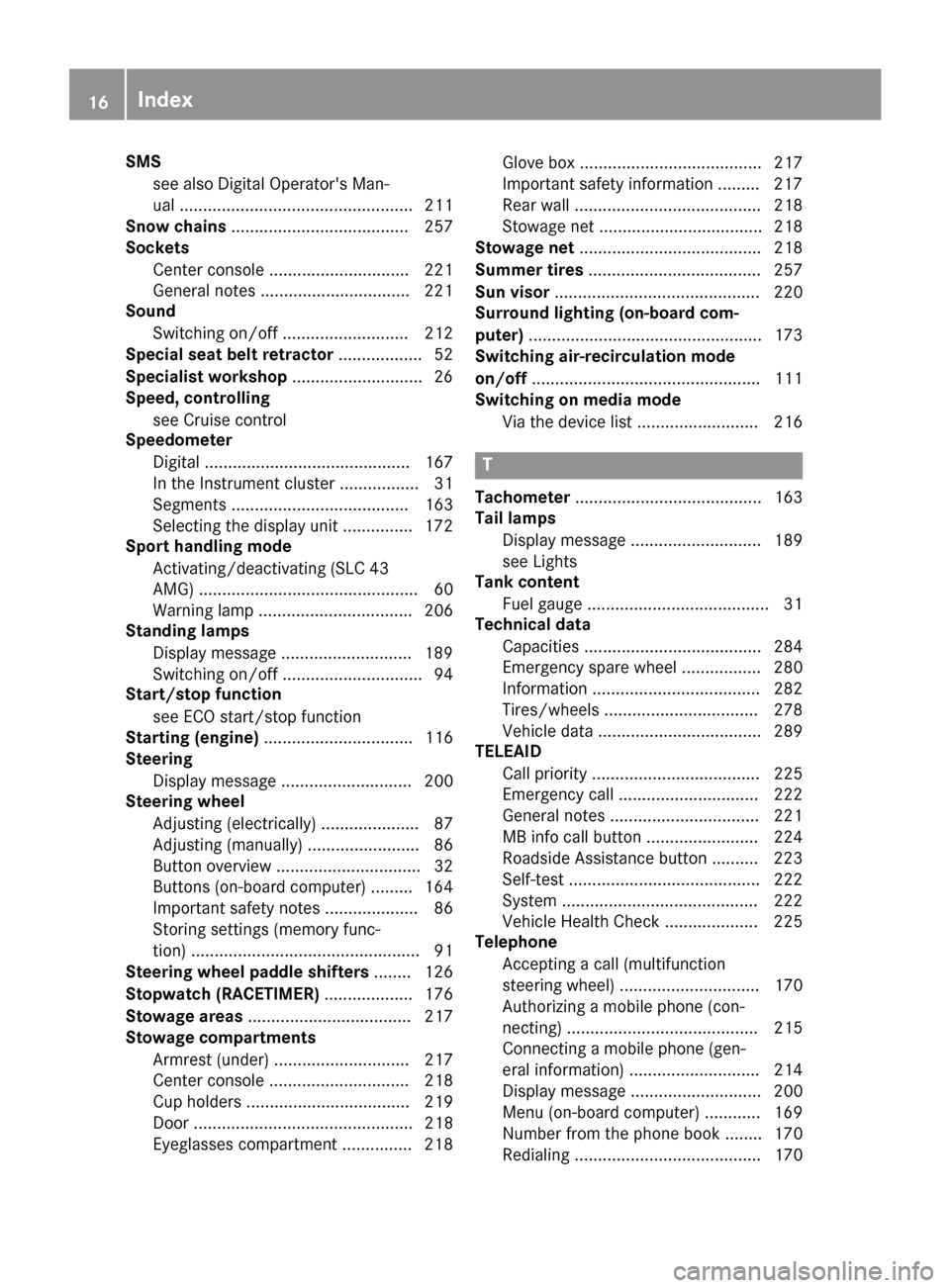
SMSsee also Digital Operator's Man-
ual .................................................. 211
Snow chains ...................................... 257
Sockets
Center console .............................. 221
General notes ................................ 221
Sound
Switchingo n/off ........................... 212
Special seat belt retractor .................. 52
Specialist workshop ............................26
Speed, controlling
see Cruise control
Speedometer
Digital ............................................ 167
In the Instrument cluster ................. 31
Segments. ..................................... 163
Selectingt he display unit ............... 172
Sport handling mode
Activating/deactivating (SLC 43
AMG) ............................................... 60
Warning lamp ................................. 206
Standing lamps
Display message ............................1 89
Switching on/off .............................. 94
Start/stop function
see ECO start/stop function
Starting (engine) ................................ 116
Steering
Display message ............................ 200
Steering wheel
Adjusting (electrically). .................... 87
Adjusting (manually). ....................... 86
Butto noverview ............................... 32
Buttons (on-board computer) ......... 164
Important safety notes .................... 86
Storing settings (memory func-
tion) ................................................. 91
Steering whee lpaddle shifters ........ 126
Stopwatch (RACETIMER) ................... 176
Stowag eareas ................................... 217
Stowag ecom partments
Armrest (under )............................. 217
Center console .............................. 218
Cu ph olders ................................... 219
Door ............................................... 218
Eyeglasses compartment ............... 218 Glove box ....................................... 217
Important safety information ......... 217
Rear
wal
l ........................................ 218
Stowag enet ................................... 218
Stowag enet....................................... 218
Summert ires..................................... 257
Sun visor ............................................ 220
Surround lighting (on-board com-
puter) .................................................. 173
Switchin gair-recirculatio nmode
on/off ................................................. 111
Switchin gonmediam ode
Via the device list .......................... 216
T
Tachometer ........................................ 163
Tail lamps
Displa ymessage ............................ 189
see Lights
Tank content
Fuelgauge ....................................... 31
Technical data
Capacities ...................................... 284
Emergency spare wheel. ................ 280
Information .................................... 282
Tires/wheels ................................. 278
Vehicl edata. .................................. 289
TELEAID
Call priority .................................... 225
Emergency cal l.............................. 222
Genera lnotes ................................ 221
MB info cal lbutton ........................ 224
Roadsid eAssistance button .......... 223
Self-test ......................................... 222
System .......................................... 222
Vehicl eHealth Check .................... 225
Telephone
Accepting acall( multifunction
steering wheel) .............................. 170
Authorizing amobilephone (con-
necting) ......................................... 215
Connecting amobilephone (gen-
era linformation) ............................ 214
Displa ymessage ............................ 200
Menu (on-board computer) ............ 169
Numbe rfrom the phone boo k........ 170
Redialing ........................................ 170
16Index
Page 138 of 294
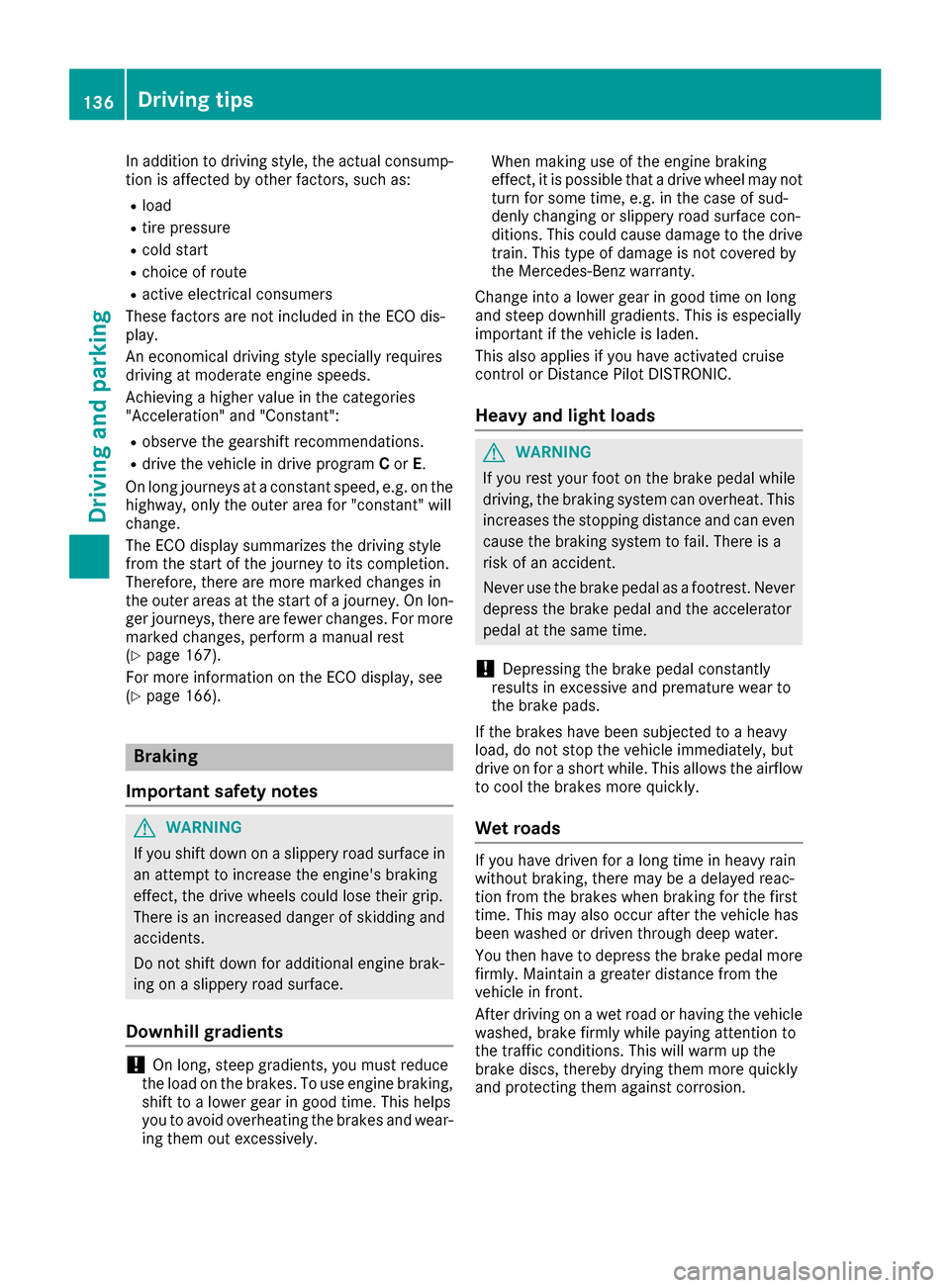
In addition to driving style, the actual consump-
tion is affected by other factors, such as:
Rload
Rtire pressure
Rcold start
Rchoice of route
Ractive electrical consumers
These factors are not include dinthe ECO dis-
play.
An economical driving style specially requires
driving at moderate engine speeds.
Achieving ahigher valu einthe categories
"Acceleration" and "Constant":
Robserve the gearshift recommendations.
Rdrive the vehicle in drive program Cor E.
On long journeys at aconstant speed,e .g. on the
highway, only the outer area for "constant" will
change.
The ECO display summarizes the driving style
from the start of the journey to its completion.
Therefore, there are more marked changes in
the outer area satthe start of ajourney. On lon-
ger journeys, there are fewer changes. For more
marked changes, perform amanua lrest
(
Ypage 167).
For more information on the ECO display, see
(
Ypage 166).
Braking
Important safety notes
GWARNING
If you shift down on aslippery road surface in
an attempt to increase the engine's braking
effect, the drive wheel scould lose their grip.
There is an increased danger of skidding and
accidents.
Do not shift down for additional engine brak-
ing on aslippery road surface.
Downhill gradients
!On long, steep gradients, you must reduce
the load on the brakes. To use engine braking,
shift to alowerg ear in good time. This helps
you to avoid overheating the brakes and wear-
ing them out excessively. When making use of the engine braking
effect, it is possible that
adrive wheel may not
turn for some time, e.g. in the case of sud-
denly changing or slippery road surface con-
ditions. This could cause damage to the drive
train. This type of damage is not covered by
the Mercedes-Benz warranty.
Change into alowerg ear in good time on long
and steep downhill gradients. This is especially
important if the vehicle is laden.
This also applies if you have activated cruise
control or Distance PilotD ISTRONIC.
Heavy and light loads
GWARNING
If you rest you rfoot on the brake pedalw hile
driving, the braking system can overheat. This increases the stopping distance and can even
cause the braking system to fail .There is a
risk of an accident.
Never use the brake pedalasaf ootrest. Never
depresst he brake pedala nd the accelerator
pedalatt he same time.
!Depressing the brake pedalc onstantly
results in excessive and premature wea rto
the brake pads.
If the brakes have been subjected to aheavy
load ,don ot stop the vehicle immediately ,but
drive on for ashort while. This allows the airflow
to cool the brakes more quickly.
Wet roads
If you have driven for along time in heavy rain
withou tbraking, there may be adelayed reac-
tion from the brakes when braking for the first
time. This may also occur after the vehicle has
been washed or driven through deep water.
You then have to depresst he brake pedalmore
firmly.M aintainagreater distance from the
vehicle in front.
After driving on awet road or having the vehicle
washed, brake firmly whil epaying attention to
the traffic conditions. This willw arm up the
brake discs, thereby drying them more quickly
and protecting them against corrosion.
136Driving tips
Driving and parking
Page 140 of 294

Drivingonw et road s
Hydroplaning
If water has accumulated to acertai ndept hon
th er oads urface, there is adanger of hydro-
planin goccurring, eve nif:
Ryou drive at low speeds
Rthet ires hav eadequat etread dept h
Fo rthisr eason ,intheevent of heav yrain or in
condition sinwhichh ydroplaning may occur ,
you mus tdrive in th efollowin gmanner:
Rlowe ryour speed
Ravoid rut s
Ravoid sudden steerin gmovements
Rbrake carefully
Drivin gonflooded road s
!Do notdrive through floode dareas. Chec k
th ed ept hofa ny water befor edrivin gthrou gh
it .D rive slowly through standin gwater. Oth-
erwise ,water may ente rthe vehicle interio ror
th ee nginec om partment. Thi scan damage
th ee lectronic component sintheengin eor
th ea utomatic transmission. Water can also
be drawn in by th eengine's air suction nozzles
and this can cause engin edamage.
Winte rdrivin g
GWARNING
If you shift down on aslipper yroads urfac ein
an attempt to increase th eengine's braking
effect ,the drive wheels could los etheir grip.
There is an increase ddanger of skidding and
accidents .
Do no tshift down fo radditional engin ebrak-
in gonas lipperyroads urface.
GDANGER
If th eexhaus tpipe is blocke doradequat e
ventilation is no tpossible, poisonous gases
suc hasc arbon monoxide (CO) may ente rthe
vehicle. Thi sisthecase, e.g. if th evehicle
becomes trappe dinsnow. There is arisko f
fatal injury.
If you leav ethe engin eortheauxiliar yheatin g
running ,makes uret he exhaus tpipe and are a
around th evehicle are clear of snow. To
ensur eana dequat esupply of fresh air, ope na
window on th esideoft hevehicle that is no t
facin gintot he wind.
Hav eyour vehicle winter-proofed at aqualified
specialis tworkshop at th eonset of winter.
Drive particularly carefully on slipper yroads ur-
faces. Avoid sudden acceleration ,steerin gand
braking maneuvers .Donotuse cruise control.
If th evehicle threatens to skid or canno tbe
stopped when movin gatlow speed:
XShift th etransmissio ntoposition N.
The outsid etem perature indicator is no t
designed to serve as an ice-warnin gdevic eand
is therefore unsuitable fo rtha tp urpose.
Changes in th eoutsid etem perature are dis -
playe dafter ashort delay.
Indicated temperature sjusta bov ethe freezin g
poin tdon otguarantee that th eroads urfac eis
free of ice. The road may still be icy, especially in
wooded areas or on bridges. The vehicle could
skid if you fail to adapt your drivin gstyle. Always
adapt your drivin gstyle and drive at aspeed to
suit th eprevailin gweather conditions.
You should pay spe cia
l attention to road condi-
tion swhen temperature sare around freezin g
point.
Fo rm orei nformati on on drivin gwiths now
chains, see (
Ypage 257).
Fo rm orei nformat ion on drivin gwiths ummer
tires ,see (
Ypage 257).
Observ ethe note sint he"Winte roperation "sec-
tion (
Ypage 257).
Drivin gsystems
Cruis econtro l
General notes
Cruise contro lmaintain saconstan troa ds peed
fo ry ou. It brake sautomatically in order to avoid
exceedin gthe set speed. On lon gand steep
downhill gradients, especially if th evehicle is
laden, you mus tselec talowe rgear in goo dtim e.
By doin gso, you will mak euse of th ebraking
effect of th eengine. Thi srelieves th eload on th e
138Driving systems
Driving an dparking
Page 141 of 294
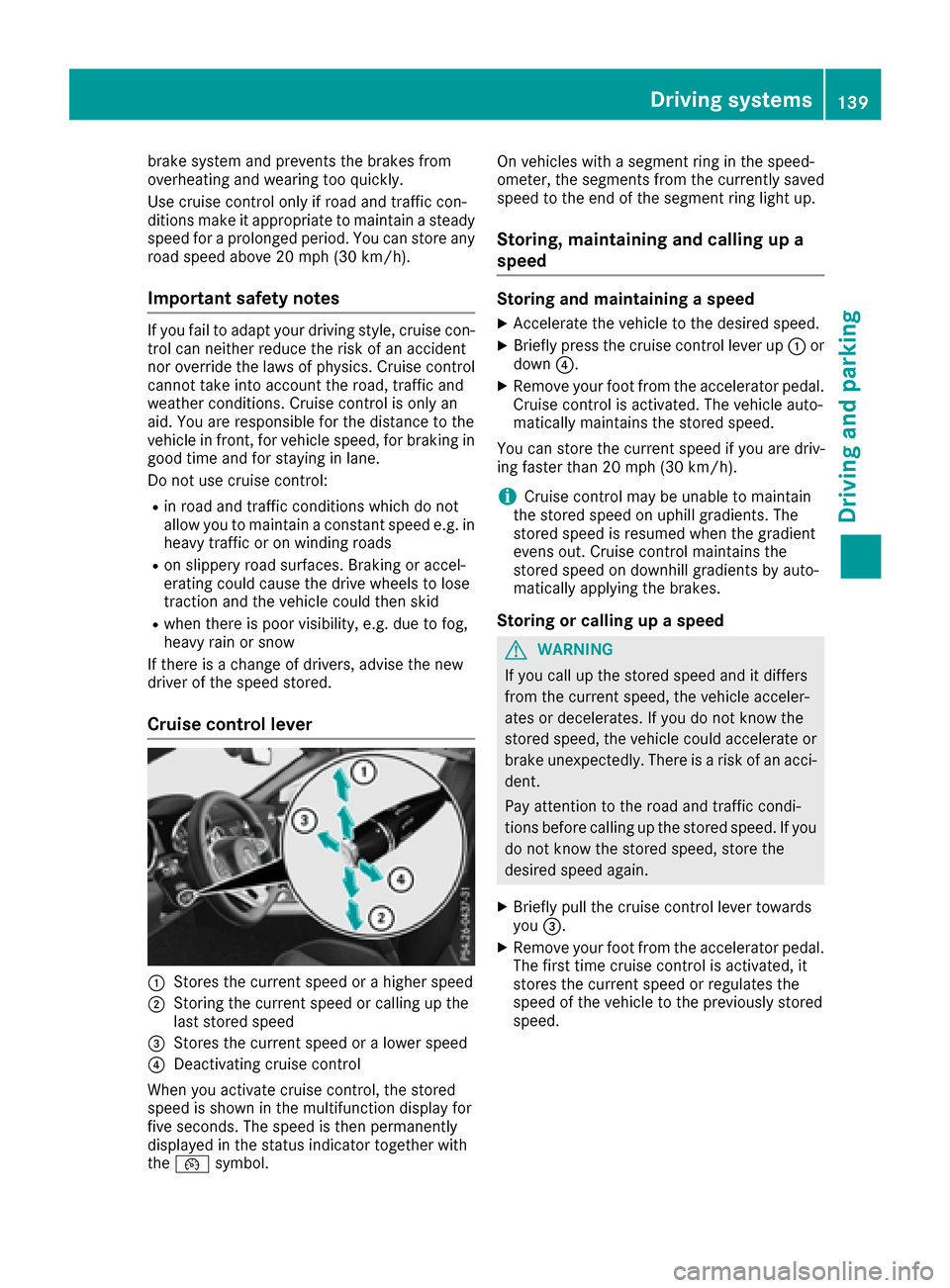
brake system and prevents the brakes from
overheating and wearing too quickly.
Use cruise control only if road and traffic con-
ditionsmake it appropriate to maintain asteady
speed for aprolonged period. You can stor eany
road speed above 20 mph (30 km/h).
Important safetyn otes
If you fail to adapt your driving style, cruise con-
trol can neither reduce the risk of an accident
nor override the laws of physics. Cruise control
cannot take intoaccountt he road, traffic and
weather conditions. Cruise control is only an
aid. You are responsible for the distance to the
vehicle in front, for vehicle speed, for brakin gin
good time and for staying in lane.
Do not use cruise control:
Rin road and traffic condition swhich do not
allow you to maintain aconstan tspeed e.g. in
heavy traffic or on winding roads
Ron slippery road surfaces.B raking or accel-
eratin gcould cause the drive wheels to lose
traction and the vehicle could then skid
Rwhen ther eispoor visibility, e.g. due to fog,
heavy rain or snow
If ther eisac hangeofd rivers, advise the new
driver of the speed stored.
Cruise control lever
:Stores the currents peed orahigher speed
;Storing the currents peed or calling up the
last stored speed
=Stores the currents peed oralower speed
?Deactivatin gcruise control
When you activate cruise control, the stored
speed is shown in the multifunction display for
five seconds. The speed is then permanently
displayed in the status indicator together with
the ¯ symbol. On vehicles with
asegmentr ing in the speed-
ometer, the segments from the currently saved speed to the end of the segmentr ing light up.
Storing, maintaining and calling up a
speed
Storing and maintainingaspeed
XAcceleratet he vehicle to the desired speed.
XBriefly press the cruise control lever up :or
down ?.
XRemove your foot from the accelerator pedal.
Cruise control is activated. The vehicle auto-
matically maintains the stored speed.
You can stor ethe currents peed if you are driv-
ing faster than 20 mph (30 km/h).
iCruise control may be unable to maintain
the stored speed on uphill gradients. The
stored speed is resumed when the gradient
evens out. Cruise control maintains the
stored speed on downhill gradient sbyauto-
matically applying the brakes.
Storing or calling up aspeed
GWARNING
If you call up the stored speed and it differs
from the currents peed, the vehicle acceler-
ates or decelerates. If you do not know the
stored speed, the vehicle could accelerateo r
brake unexpectedly. There is arisk of an acci-
dent.
Pay attention to the road and traffic condi-
tion sbefore calling up the stored speed. If you
do not know the stored speed, stor ethe
desired speed again.
XBriefly pull the cruise control lever towards
you =.
XRemove your foot from the accelerator pedal.
The first time cruise control is activated, it
stores the currents peed or regulates the
speed of the vehicle to the previously stored
speed.
Driving systems139
Driving and parking
Z
Page 142 of 294

Settingaspeed
GWARNING
Keep in mind that it may take abrief moment
until the vehicle has made the necessary
adjustments.
Increase or decrease the set vehicle speed to
av alue that the prevailing road conditionsa nd
legal speed limits permit. Otherwise, sudden
and unexpected acceleration or deceleration
of the vehicle could cause an accident and/or
serious injury to you and others.
XTo adjust the set speed in 1mph incre-
ments (1 km/h increments): briefly press
the cruise control lever up :to the pressure
point for ahigher speed, or down ?for a
lower speed.
Every time the cruise control lever is pressed
up or down, the last speed stored is increased
or reduced.
XTo adjust the set speed in 5mph incre-
ments (10k m/h increments): briefly press
the cruise control lever up :past the pres-
sure point for ahigher speed, or down ?for
al ower speed.
Ever ytime the cruise control lever is pressed
up or down, the last speed stored is increased
or reduced.
iThe speed indicated in the speedometer
may differ slightly from the speed stored.
iCruise control is not deactivated if you
depress the accelerator pedal. For example, if you accelerateb riefly to overtake, cruise con-
trol adjusts the vehicle's speed to the last
speed stored after you have finished overtak-
ing.
Deactivating cruise control
There are several ways to deactivate cruise con-
trol:
XBriefly press the cruise control lever for-
wards :.
or
XBrake.
Cruise control is automatically deactivated if:
Ryou engage the electric parkin gbrake
Ryou are driving at less than 20 mph (3 0km/ h)
RESP®intervenes or yo udeactivate ESP®
Ron vehicles with manua ltransmission, you
shift to agearthati stoo high, and as aresult
the engine spee distoo low
RBrake Assist intervenes
Ryous hift fromt ransmission position D
If cruis econtro lisdeactivated ,you will hear a
warning tone .You will see the Cruise con‐
troloffmessage in the multifunctio ndisplay
for approximately fiv eseconds.
iWhen yo uswitch off the engine ,the last
spee dstored is deleted.
Distance Pilo tDISTRONIC
General notes
Distance Pilo tDISTRONI Cregulate sthe speed
and automaticall yhelps youm aintain the dis-
tance to the vehicl edetecte dinf ront. The sys-
tem detects vehicles using the rada rsensor sys-
tem. Distance Pilo tDISTRONI Cbrakes automat-
icall ytoa voidexceeding the set spee dorto
maintain the designated distance fromt he vehi-
cle in front.
Chang einto alower gear in good time on long
and stee pdownhil lgradients .Thisise specially
140Driving system s
Driving an dparking
Page 144 of 294
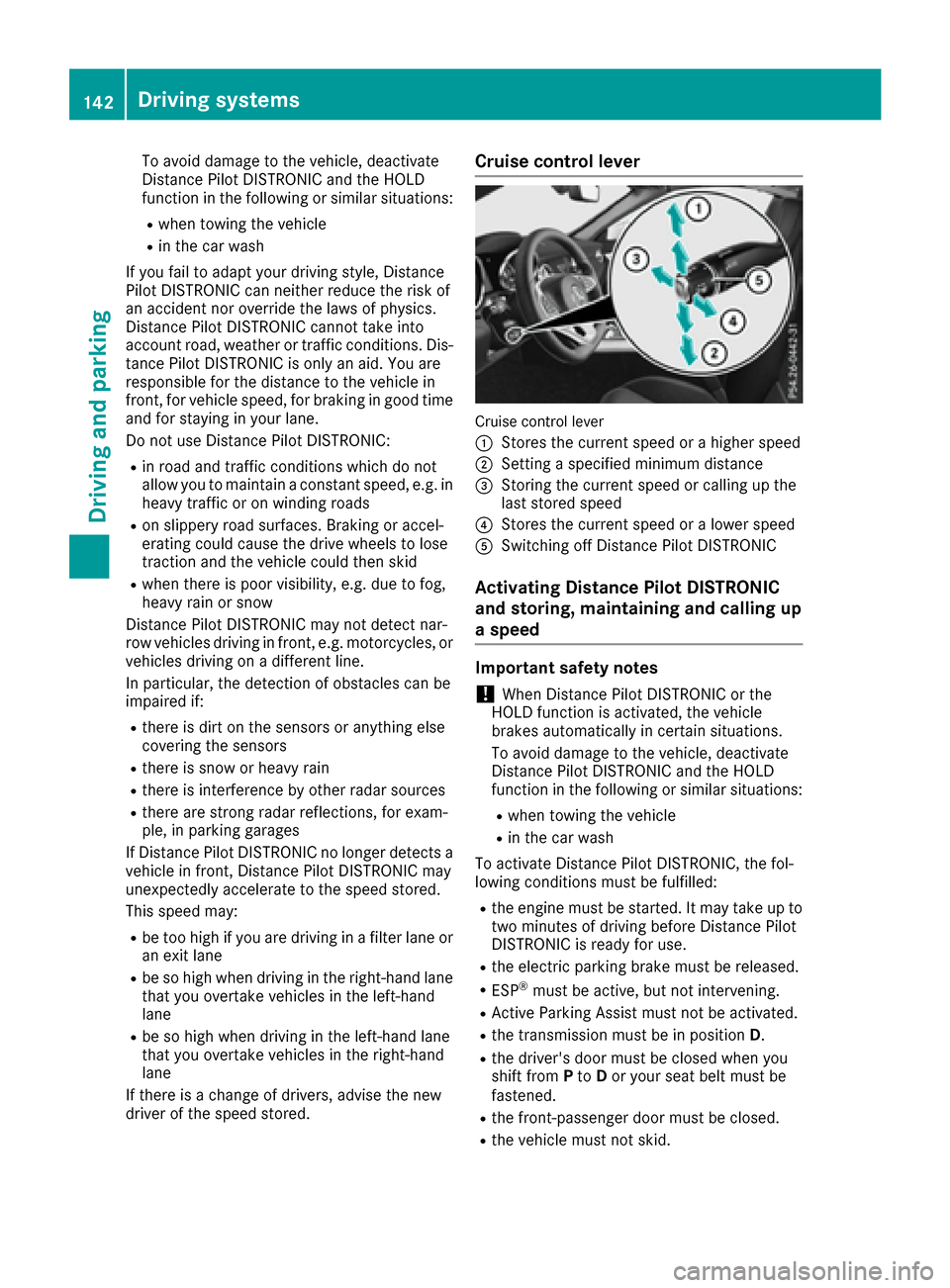
To avoid damage to the vehicle, deactivate
Distance Pilot DISTRONIC and the HOLD
function in the following or similar situations:
Rwhen towing the vehicle
Rin the car wash
If you fail to adapt your driving style, Distance
Pilot DISTRONIC can neither reduce the risk of
an accident nor override the laws of physics.
Distance Pilot DISTRONIC cannot take into
account road, weather or traffic conditions. Dis-
tanc ePilot DISTRONIC is only an aid. You are
responsible for the distance to the vehicle in
front,f or vehicle speed, for braking in good time
and for staying in your lane.
Do not use Distance Pilot DISTRONIC:
Rin road and traffic conditions which do not
allow you to maintain aconstant speed, e.g. in
heavy traffic or on winding roads
Ron slippery road surfaces. Brakingora ccel-
erating could cause the drive wheels to lose
traction and the vehicle could then skid
Rwhen there is poor visibility, e.g. due to fog,
heavy rain or snow
Distance Pilot DISTRONIC may not detect nar-
row vehicles driving in front,e .g. motorcycles, or
vehicles driving on adifferent line.
In particular, the detection of obstacles can be
impaired if:
Rthere is dirt on the sensors or anything else
coveringt he sensors
Rthere is snow or heavy rain
Rthere is interferenc ebyother radar sources
Rthere are stron gradar reflections, for exam-
ple, in parking garages
If Distance Pilot DISTRONIC no longer detect sa
vehicle in front,D istance Pilot DISTRONIC may
unexpectedly accelerate to the speed stored.
This speed may:
Rbe too high if you are driving in afilter lane or
an exit lane
Rbe so high when driving in the right-hand lane that you overtak evehicles in the left-hand
lane
Rbe so high when driving in the left-hand lane
that you overtak evehicles in the right-hand
lane
If there is achange of drivers, advise the new
driver of the speed stored.
Cruise control lever
Cruise control lever
:
Stores the current speed or ahigher speed
;Setting aspecified minimum distance
=Storing the current speed or calling up the
last stored speed
?Stores the current speed or alower speed
ASwitching off Distance Pilot DISTRONIC
Activating Distance Pilot DISTRONIC
and storing, maintaining and calling up
as peed
Important safety notes
!When Distance Pilot DISTRONIC or the
HOLD function is activated, the vehicle
brakes automatically in certain situations.
To avoid damage to the vehicle, deactivate
Distance Pilot DISTRONIC and the HOLD
function in the following or similar situations:
Rwhen towing the vehicle
Rin the car wash
To activate Distance Pilot DISTRONIC, the fol-
lowing conditions must be fulfilled:
Rthe engine must be started. It may take up to
two minutes of driving before Distance Pilot
DISTRONIC is ready for use.
Rthe electric parking brake must be released.
RESP®must be active, but not intervening.
RActive Parking Assist must not be activated.
Rthe transmission must be in position D.
Rthe driver's door must be closed when you
shift fromPto Dor your seat belt must be
fastened.
Rthe front-passenger door must be closed.
Rthe vehicle must not skid.
142Driving systems
Driving and parking
Page 145 of 294
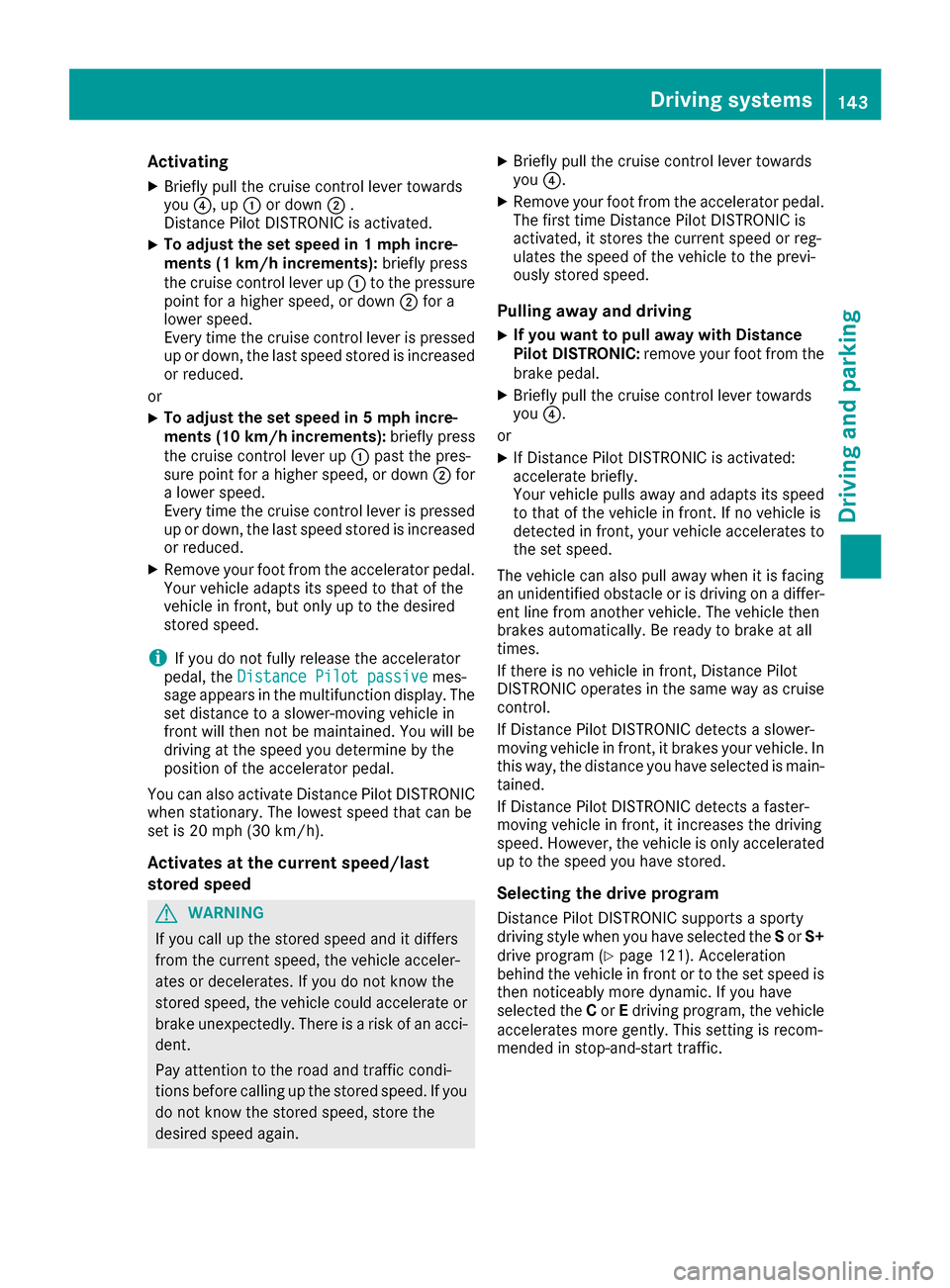
Activating
XBrieflypull th ecruise control leve rtow ards
you ?,u p: or down ;.
Distance Pilot DISTRONI Cisa ctivated.
XTo adjust th eset speed in 1mphincre-
ments (1 km/h increments): briefly press
th ec ruise control leve rup: to th epressur e
poin tfor ah igher speed, or down ;for a
lower speed.
Every tim ethe cruise control leve rispresse d
up or down ,the last spee dstoredisi ncreased
or reduced.
or
XTo adjust th eset speed in 5mphincre-
ments (10k m/h increments): briefly press
the cruise control lever up :past the pres-
sure point for ahigher speed, or down ;for
al ower speed.
Ever ytime the cruise control lever is pressed
up or down, the last speed stored is increased
or reduced.
XRemove your foot from the accelerator pedal.
Your vehicle adapts its speed to that of the
vehicle in front, but only up to the desired
stored speed.
iIf you do not fully release the accelerator
pedal, the DistanceP ilot passivemes-
sage appears in the multifunction display. The
set distanc etoaslower-moving vehicle in
frontw ill then not be maintained. You will be
driving at the speed you determine by the
position of the accelerator pedal.
You can also activate Distance Pilot DISTRONIC
when stationary. The lowest speed that can be
set is 20 mph (30 km/h).
Activates at the current speed/last
stored speed
GWARNING
If you call up the stored speed and it differs
from the currents peed, the vehicle acceler-
ates or decelerates. If you do not know the
stored speed, the vehicle could accelerateo r
brake unexpectedly. There is arisk of an acci-
dent.
Pay attention to the road and traffic condi-
tion sbefore calling up the stored speed. If you
do not know the stored speed, stor ethe
desired speed again.
XBriefly pull the cruise control lever towards
you ?.
XRemove your foot from the accelerator pedal.
The first time Distance Pilot DISTRONIC is
activated, it stores the currents peed or reg-
ulates the speed of the vehicle to the previ-
ously stored speed.
Pulling away and driving
XIf you want to pull away with Distance
Pilot DISTRONIC: remove your foot from the
brake pedal.
XBriefly pull the cruise control lever towards
you ?.
or
XIf Distance Pilot DISTRONIC is activated:
accelerateb riefly.
Your vehicle pulls away and adapts its speed
to that of the vehicle in front. If no vehicle is
detected in front, your vehicle accelerates to the set speed.
The vehicle can also pull away when it is facing
an unidentified obstacle or is driving on adiffer-
ent line from another vehicle. The vehicle then
brakes automatically. Be ready to brake at all
times.
If ther eisnov ehicle in front, Distance Pilot
DISTRONIC operates in the same way as cruise
control.
If Distance Pilot DISTRONIC detects aslower-
movingv ehicle in front, it brakes your vehicle. In
this way, the distanc eyou have selected is main-
tained.
If Distance Pilot DISTRONIC detects afaster-
movingv ehicle in front, it increases the driving
speed. However, the vehicle is only accelerated
up to the speed you have stored.
Selecting the drive program
Distance Pilot DISTRONIC supports asporty
driving style when you have selected the Sor S+
drive program (
Ypage 121). Acceleration
behind the vehicle in frontortothe set speed is
then noticeably more dynamic. If you have
selected the Cor Edriving program, the vehicle
accelerates more gently. This setting is recom-
mended in stop-and-start traffic.
Driving systems143
Driving and parking
Z
Page 146 of 294

Changing lanes
If you want to change to theovertakin glane on
multi-lan eroads ,Distance Pilot DISTRONIC sup-
port syou if
Ryou are driving faster than 45 mph (70 km/h)
RDistance Pilot DISTRONIC is maintaining the
distanc etoav ehicle in front
Ryou switch on th eappropriat eturns ignal
RDistance Pilot DISTRONIC does no tcurrently
detect adanger of collision
If these conditionsa re fulfilled, your vehicle is
accelerated. Acceleration will be interrupte dif
changingl anestakes to olongorift hedistance
between your vehicle and th evehicle in front
become stoo small.
iWhen you change lanes, Distance Pilot
DISTRONIC monitors th eleft lane (on left-
hand-driv evehicles) or th erigh tlane (on right-
hand-driv evehicles).
Stopping
GWARNING
If you leave th evehicle when it is only being
braked by Distance Pilot DISTRONIC, it could
roll away if:
Rthere is amalfunctio ninthesystem or in
th ev oltage supply.
RDistance Pilot DISTRONIC is switche doff
usingt hecruise control lever, e.g .byavehi-
cle occupant or from outside th evehicle
Rthee lectrical system in th eengine com-
partment, th ebattery or th efuse sare tam-
peredw ith.
Rtheb attery is disconnected
Rthev ehicle is accelerated, e.g .byavehicle
occupant.
Thereisar isk of an accident.
Before leavingt hevehicle ,always deactivate
Distance Pilot DISTRONIC and secure the
vehicle against rolling away.
Further informatio nondeactivatin gDistance
Pilot DISTRONIC (
Ypage 146).
If Distance Pilot DISTRONIC detect sthatthe
vehicle in frontiss topping, it brakes your vehicle
until it is stationary. Once your vehicle is stationary, it remains sta-
tionar
yand you do no tneedtod epress the
brake.
iAfte ratime, th eelectric parking brake
secures th evehicle and relieves th eservice
brake.
iDependingont hespecified minimum dis-
tance, your vehicle will com etoastandstil lat
as ufficient distanc ebehindt hevehicle in
front. The specified minimum distanc eisset
usingt hecontrol on th ecruise control lever.
When Distance Pilot DISTRONIC is act ivated,
t
h et ransmission is shifte dautomatically to
position Pif:
Rthed river'ss eat belt is no tfastene dand the
driver'sd oor is open.
Rthee ngine is switched off ,unless it is auto-
matically switched off by th eECO start/stop
function.
The electric parking brak esecures th evehicle
automatically if Distance Pilot DISTRONIC is
activated when th evehicle is stationar yand:
Rasystem malfunctio noccurs.
Rthep ower supply is no tsufficient.
If am alfunctio noccurs, th etransmission may
also shifti ntop osition Pautomatically.
Settin gaspeed
Keep in mindt hatitm ay tak eabriefm oment
until th evehicle has accelerate dorbraked to
th es peeds et.
XTo adjust th eset spee din1m phincre-
ments (1 km/h increments): briefly press
th ec ruise control leveru p: to th epressure
pointf orah igher speed, or down ;for a
lower speed.
Every tim ethe cruise control leverisp ressed
up or down,t helast speeds toredisi ncreased
or reduced.
XTo adjust th eset spee din5m phincre-
ments (10k m/h increments): briefly press
the cruise control lever up :past the pres-
sure point for ahigher speed, or down ;for
al ower speed.
Ever ytime the cruise control lever is pressed
up or down, the last speed stored is increased
or reduced.
144Driving systems
Driving and parking